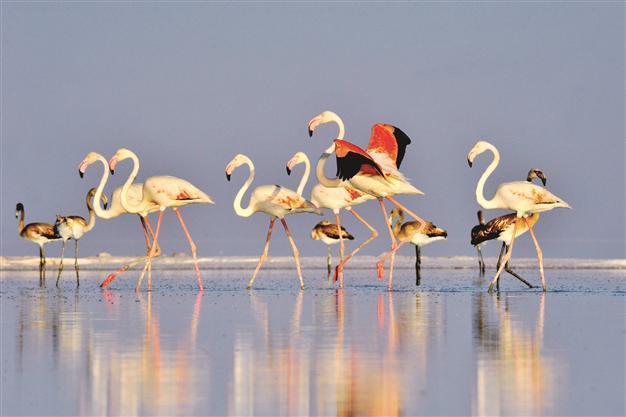Flamingos prepare to take flight on southward journey
AKSARAY - Anadolu Agency

Lake Tuz is home to one of the biggest populations of flamingos anywhere in the world.
Winter might seem a long way’s off amid the searing temperatures around Turkey, but for the thousands of flamingos who call Central Anatolia’s Salt Lake (Salt Lake) home, the time for migration to more clement climes draws ever nearer.“The young ones have started flying – just short distance for the time being. In two months, they will be able to fly long distance as mature individuals,” said Süreyya İsfendiyaroğlu, the science coordinator of the Nature Foundation.
Lake Tuz is home to one of the biggest populations of flamingos anywhere in the world; the famous pink birds have been monitored regularly by the Nature Foundation and the French nongovernmental organization Tour du Valat since 2003. “Along with the Gediz Delta, the globally important Lake Tuz is one of Turkey’s two main reproduction habitats for flamingos. Flamingos migrate seasonally in order to carry out their vital functions such as feeding, nesting and nurturing,” said İstendiyaroğlu.
“They prefer salty and watery areas to live and reproduce in. The most important salty region in the Mediterranean countries is Lake Tuz. Flamingos come here every year to reproduce. Lake Tuz is like heaven for them. Upon their arrivals in March, they incubate, and their offspring hatch in May and June. The nestlings that feed on in the lake and can fly short distances migrate to southern countries after they mature in September,” he said.
“The number of flamingos that hatch every year varies, and the most important reason of this variation is the water level in the lake,” İsfendiyaroğlu said.
Despite the modern world’s encroachment on the natural habitat of animals, the numbers of flamingos born each year has largely grown since 2005. Some 3,309 were born in 2005; 4,382 in 2007; 1,610 in 2008, 14,644 in 2009; 4,321 in 2010 and 18,418 in 2011. “The number in 2011 was the greatest hatching ever recorded in West African and Mediterranean countries,” he said, while noting that the record was broken the next year, when 20,272 hatchlings were born. “In total, more than 60,000 flamingos were in the lake in 2012. This was recorded as the biggest counted flamingo population in the world,” he said.
Countdown to journey
“In the beginning of July we had a flight over the reproduction islands in Salt Lake. Our research team that took many photographs during the flight began counting the flamingos using these images. We observed thousands of flamingo offspring that were spread across a vast region,” he said.
Pointing out the fatal dangers in the flamingo sanctuary, İsfendiyaroğlu said: “The most important factors threatening Lake Tuz’s destruction are dams, deep well bores, disruption of the natural water cycle and especially agricultural products such as sugar beet that consume a lot of water and are not suitable to grow in the lake.”
As such, İsfendiyaroğlu recommended that agricultural projects in the vicinity of the lake be well-organized and environmentally friendly to prevent further harm to the flamingos.

















